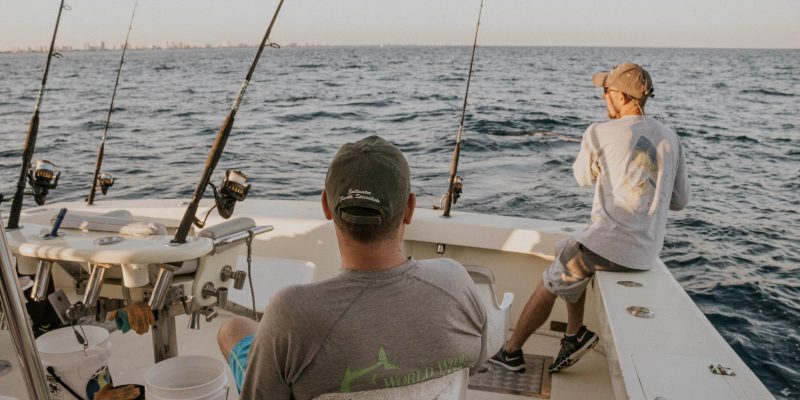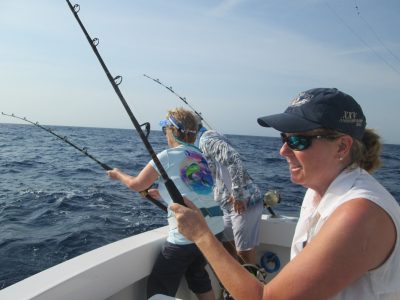Fighting many saltwater fish can test your strength. Here are 10 helpful tips to help you fight – and land – these powerful fish. You can use these techniques for conventional and spinning reels, offshore or inshore.
- Don’t place the rod butt under your arm. Technique is critical for success. Place it on your hip for the correct stance and power to fight the fish. If the fish is very heavy, it’s ok to reel while the rod is still in the rod holder but you may need to take it out of the holder as the fish nears.
- For heavy fish, let the fish run in the beginning, then pump and reel when it stops taking line. Pumping means lifting the rod tip towards the sky and reeling as you slowly lower the rod tip back to the water. You can also use this technique when sitting in a fighting chair. Don’t fret if you feel you are not making progress. If you can only get half a crank when lowering the rod, eventually you will bring the fish to the boat. A lively fish may run several times and you have to reel it back again. It’s part of the excitement!
- For how low and high to pump, use from 2 to 3 o’clock as a guide. If you raise the rod too high you risk breaking it. If too low, you lose the advantage of the drag and the rod action to retrieve the fish and risk breaking the line when when the rod is pointed directly at the fish. Pound test is the weight where a line breaks at a direct pull. However, you can catch a 40 lb. fish with 20 lb. test, for instance, by utilizing the bend in the rod, drag system and pump and reel method.
- Keep a bend in the rod at all times. Slack is your enemy. A slack or straight-up rod means there is no pressure on the fish and the hook could easily come out of the fish’s mouth. If you don’t feel pressure, keep reeling as the fish may be swimming directly to you. You might want to practice the pump and reel technique by placing a bucket at the end of the line, letting it out, then reeling it in.
- Have a fighting belt handy to place between the rod butt and your abdomen. Without it, you may experience pain from the pressure. The easiest fighting belts are those that can be quickly attached around your waist with velcro. Ask someone to attach it – if you do it yourself or look down you may lower the rod too much and lose the pressure on the fish. Place the belt a bit below your hips with the straps around the back of your waist so you can straighten your arms on the rod and relax when the fish is running. The other reason for this belt location is so you can use your hips to push up and raise the rod, saving your arms from tiring. This is especially helpful for women and shorter anglers.
- Other gut protection devices that are simply inserted at the end of the rod butt are a Rod Huki (looks like a T bar) or CushIt (made from material similar to Crocs). For these, you simply insert at the rod butt and place on your hip. If you have none of these handy, fold up a fish towel, put in your pocket and place the rod butt there.
- Keep an eye on your rod tip as when a fish jumps, the temporary slack can wrap the line around the top. When this happens you can no longer reel. Unwrap the line and keep fishing.
- Keep your rod pointed towards the fish when it changes location. If fighting a fish while standing up, move around the boat with small steps to keep your rod pointed towards the fish. Ask other anglers to help remove rods that may be in your way. As the fish nears the boat, guide the fish towards the gaff or net, keeping it in the water and under control.
- Once the fish is in the boat, it may flop around until you can get it in the cooler. Let a little line out until the hook can be removed. Rinse away any fish blood on the deck as it is slippery and more difficult to remove once dry.
- After you have caught the fish, do not reel terminal tackle (sinkers, snap swivels, lure, or anything hard) all the way to the rod tip. It can break the rod’s top eye, so leave an inch of line or so. Some spinning rods have a metal loop at the bottom of the reel for securing your hook or lure. Do not put the hook directly on the eye as most are ceramic and it will cause a problematic nick. For treble hooks, you can secure them at the metal ring that attaches to the rod’s bottom eye. Be careful when placing a rod back with a treble hook – it can snag your shirt or even worse, your skin. That’s why it is safer to secure it at the bottom eye. There are plastic treble hook covers available to prevent such injuries. Let them snag the fish, not the anglers.
Catching saltwater fish is one of the most challenging but exciting endeavors in angling. With these 10 helpful tips, you may significantly improve your chances and create a fishing memory.
Happy saltwater fishing!


